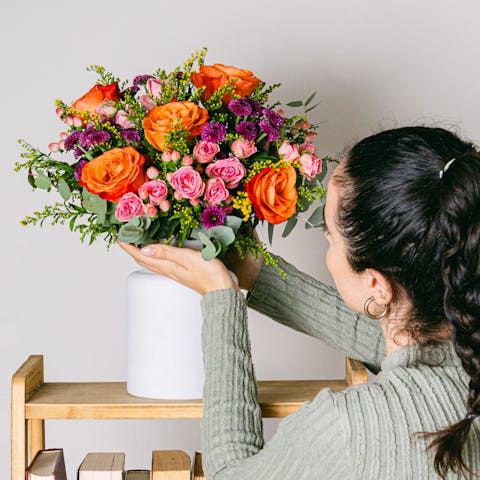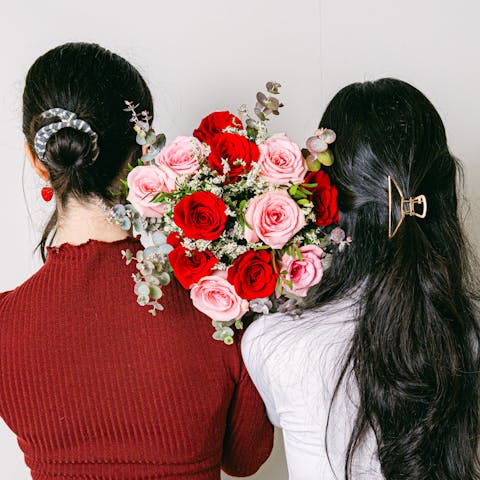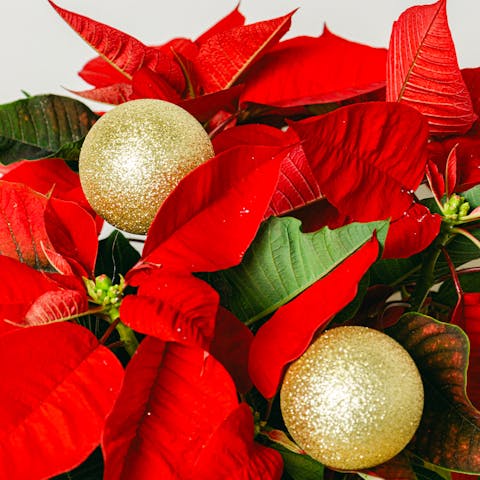Floral Journey
Featured Posts

Gourmet Gift Basket
When you are looking for a way to express gratitude, opting for a gourmet gift basket ensures you select a gift that will be memorable and well-received.

How to send flowers and gifts remotely for a perfect Valentine's Day
Discover the best tips for sending flowers and gifts remotely this Valentine's Day. Surprise your loved one no matter the distance and make the day unforgettable.

Stunning Valentine's Day Flowers That Speak Your Heart
Red roses are the classic symbol of love for Valentine's Day, but the world of floral arrangements offers much more diversity and charm to express your feelings. Explore unique and meaningful alternatives to surprise your loved ones on this special day.

Types of Flowers To Consider When Choosing The Perfect Gift
Annual types of flowers are popular gifts due to their vibrant colors and season-long blooms. Affordable options like cosmos and zinnias bring a summery feel and express emotions with colors from pastels to bold shades. Cosmos, blooming from midsummer to autumn, adds joy and energy to any space.

How to Make a Special Person Happy with Flowers Delivery
Choosing the right flowers to give as a gift can make a big difference, and some key tips can help you achieve it. First, consider the occasion. Every event has a special type of flower, such as lilies for birthdays or red roses for anniversaries, that help convey appropriate emotions.

The best plants and flowers for your home-delivered Christmas gifts
Gift flowers this Christmas with options like the Poinsettia and bouquets of red flowers. You can also create Christmas arrangements at home and take advantage of home delivery to ensure your gifts arrive on time. Giving flowers is a beautiful way to share love this season.

The Best Gifts for Singles' Day: Ideas for Personalized Gifts
On November 11, Singles' Day celebrates singleness and self-love. It was born in China in the 90s and today is a global shopping and self-care event. It's a great time to pamper oneself, give special gifts, or enjoy experiences that celebrate independence.

Celebrate International Poinsettia Day and Discover Its Origin
The poinsettia, or "Christmas flower," is a plant native to Mexico used by the Aztecs in rituals. It became a Christmas symbol when diplomat Joel Roberts Poinsett brought it to the United States in the 19th century, originating International Poinsettia Day on December 12th. On this date, the plant is celebrated for its beauty and variety of colors, and it is common in Christmas decorations and gifts.
Discover More Content
Bright and Bold: The Orange Lily - A Meaningful Gift for Any Occasion
Discover the meaning behind the vibrant orange lily and why it's the perfect gift for any occasion. From celebrating achievements to expressing gratitude, learn when to gift this beautiful flower and the benefits of choosing home delivery to make a lasting impression.
Gift Baskets: the perfect surprise for loved ones
Gift baskets are popular for all types of gifts, from the closest birthday to celebrations that could be considered sacred, such as an anniversary, and not only that, they are decorated inside, as they are filled with carefully selected contents that also evoke delight and surprise.
Discover the Best Options for Sending Gift Baskets and Flowers Online
Learn how to buy flowers and gifts online in Spain, and find the best options to surprise for any special occasion. From personalized gift baskets to delivery anywhere in the country, here is everything you need to know to make an unforgettable gift.
The power of giving flowers
Psychological and emotional benefits of giving flowers
Mood improvement
The simple act of receiving flowers has a significantly positive impact on a person's mood
23 Seasonal Floral Decoration Ideas: Bringing Nature’s Beauty into Your Home
Flowers have an innate charm that can instantly brighten up any space. They bring a touch of nature’s beauty into our homes, creating a refreshing and inviting atmosphere. Seasonal floral decorations are a wonderful way to embrace the changing seasons and infuse your home with a burst of color and fragrance. In this article, we […]
Why Marigold Is a Staple in Many Cultures
Do you ever wonder why marigold is so beloved in various cultures? Take a journey with us as we explore the rich history, symbolism, and significance of this vibrant flower. From religious ceremonies to traditional medicine, marigold plays a vital role in many aspects of life.
How To Grow Succulents Indoors
The process of growing succulents indoors can be seen as a metaphor for life. Just like in life, it is important to create the right environment and give your succulents the right amount of care and attention. With patience and practice, you can enjoy a beautiful indoor oasis that adds life and beauty to any […]
How to choose the best plants and flowers to decorate your home
You’ve probably seen plenty of houses decorated with plants that make you want to fill yours up with pots and vases. Yet, when you set out to do it you have no idea where to begin. The possibilities are endless, and often you don’t know whether the flower or the plant you like so much […]
What Are the Best Happy Birthday Roses?
There are numerous ways to wish someone a happy birthday. While you could opt for traditional gifts, you could also provide the person with a bouquet full of gorgeous roses. For many people, giving Flowers seems a bit old and out of touch, but this traditional method of making those you love smile is still […]
How Long Do Flowers Last and How Can We Enjoy A Fresh Bouquet
Nature always has a beautiful way of adapting and creating life, no matter the circumstances. However, the life that disappears is also part of nature. Just like us, any organism that’s part of this world needs certain conditions in order to survive and evolve. Depending on what type of life you have, on how solicited […]
How to Plant Flowers – Everything You Need to Know About Having A Successful Garden
If you have finally decided on having your flower garden, but you are not sure what are the steps to it, you are in the right place. This article provides all the information you need. Whether you’ve done this before or you are a first timer, you are about to find out a sequence of […]
Learn Different Easy and Quick Techniques to How to Paint Flowers
The beauty of flowers has inspired artists for several centuries. Floral art is very popular to the point of transcending artistic means and movements. No matter how they are created, painters have wanted to capture their captivating beauty on paper, canvas, and other tools. Although you might think that painting is something only professionals should […]
Types of Red Flowers, Their Meanings, And Which One Suits You Best
If you’re passionate about nature and all the beauties that it offers us, you most definitely like flowers as well. Flowers are common, and you can see them everywhere, and that’s understandable. All of us should keep flowers in our homes or gardens since they produce a lot of positive outcomes in our lives. We […]
Multi-Colored Roses: The Beautiful Rainbow
Would you like to offer a floral gift, but, at the same time, you want to make it memorable? Well, in this case, the rainbow roses are what you are looking for! Their mix of bright colors surely put a smile on anyone’s face! If the name sounds somewhat familiar, it is because you might […]
Incredible Same Day Delivery Gifts
One of the amazing things about the many ways that gifts can be given is that you are afforded the option to have these incredible gestures sent to those you care about at will. Though there is still a sense of appeal in hand-delivering your own gifts, you also have the option of having them […]
Fun Ways to Deliver Flowers to Your Lover
There is no greater way to show how much you care to your lover than with flowers. Whether it’s a single delicate rose or a bouquet of wildflowers you put together with a florist, or even a bunch of wildflowers you went out and lovingly picked, flowers just say I love you in a way […]
Order Flowers Online for Delivery to Surprise Your Lover Without Moving from Your Couch
Every day, you meet people. Some of them are really important, while others are not. In this world full of stressful days, work, obligations, and competition to be the best in your field, it is hard to give time for your beloved ones and tell them how essential they are for you. Yes, working is […]
Pink Flowers on Trees: Exploring the Beauty of Nature
Pink flowers on trees can come from a variety of different species, including cherry, dogwood, magnolia, and apple trees, among others. These trees typically bloom in the spring, producing showy pink flowers that can range in shade from pale pink to deep magenta. The timing and duration of the blooms can vary depending on the […]
Why You Should Consider Next Day Flower Delivery
Have you ever been pressed for time to send someone a gift for any reason? Whether it’s a birthday or something else, you may have forgotten or put it off. Now, you’re rushing to try to find the right item. Often, flowers are the best choice because they are bright and cheerful. Plus, many are […]
What Do Your Valentine’s Day Roses Say About You?
The celebration of love might be a reason of stress for most of us. We are trying relentlessly to find the best presents for our loved ones, and a bouquet of fresh, beautiful roses is a traditional gesture. However, have you considered that colors have particular meanings? Merely choosing some roses might not be the […]
Why Plant Gifts Are an Excellent (and Rarely Thought of) Option
For most people, giving a gift is a tough decision. You want something that is functional and is going to stand the test of time. Plant gifts are something to consider because they are going to last longer than flowers and can help people have something to do. They need to be cared for, so […]
Spray Roses – How to Care for Them and Growing Tips
Spray roses, also known as sweetheart roses, are a wonderful variety that come in clusters and offer a vivid vibe to your garden or floral arrangement. They are delicate, miniature roses and can also be grown in a pot. Let’s find out more about: * What are spray roses * Are spray roses suitable as […]
Discover the Meaning and Symbolism of Daisy Bouquet
The daisy is a hardy plant that adorns gardens between June and August. It requires little maintenance and multiplies quickly. You can find the daisy in flowerbeds, on borders, or in planters. With its beautiful white or yellow flowers, the daisy is an essential perennial plant in a natural garden, and a large mixed border, […]
How Does a Greenhouse Work?
For those who live in a climate unfavorable to year-around gardening, a greenhouse is a solution. A greenhouse helps stimulate plant growth. A greenhouse also lets you grow plants that might not survive in a non-controlled environment. Understanding the workings of a greenhouse can help you get the most of yours. Here is some information […]
When Transplanting A Plant from A Pot To The Ground, You Should Follow These Few Steps
All of us wonder at some point about the proper way of transplanting a plant from a pot to the ground. This is an essential process because the plant needs to have a healthy start in order not to wither. This involves a lot more than merely taking the plant and place it in a […]
Here Is How to Win Her Back After a Break-Up
Winning back your partner is a difficult challenge that is not easy to win. Getting back to your loved one is still a tough equation, mainly if the breakup was a painful one. While your partner may say the relationship is over, this is not the case for you. Maybe you have reasons to continue […]
Mother’s Day Flowers: Top Flowers for Mother’s Day
Flowers are an excellent way to tell your mom how much you love her on Mother’s Day, whether it’s your mom, grand mom or step mom, nothing says “I love you” better than a breathtaking bouquet. Mother‘s Day flowers have different meanings and express mixed feelings, and it is dedicated to showing gratitude, love, affection, […]
Discover the Best Thankful Quotes for a Happy and Healthy Life
Being thankful and expressing your gratitude is an essential part of being joyful in life. Finding the proper way to thank others for their kindness or even reminding ourselves just how much we have to be thankful for can be rewarding. Whether you’re crafting a custom thank you card or planning your thank you cards […]
Tips for Dinner Party Themes, Matching Flowers and Décor
Throwing a dinner party can be a lot of work, but if you have a knack for hosting, it can be a lot of fun as well. Planning every part of the night is the key to success. You have to think of the menu, the group size, the service, the venue, and the silverware […]
Sending the Perfect Birthday Balloon Delivery
Birthdays are an extraordinary occasion that takes place each year. Celebrating with a bunch of balloons is a great tradition for people of all ages. Perhaps you are hosting a birthday party or want to give someone balloons on their birthday, consider doing so by having the balloons delivered. Everyone is busy, so taking the […]
Buy a Flower Gift for Your Close Friends
All over the world, flowers represent an important synonym of love, trusting friendship, and emotions. Offering someone a flower gift means that you care about him a lot. Beautiful flowers are an incredible present for a large number of events and a good decorative element for many occasions. It is very hard to find someone […]
Get Your Next Beautiful Bouquet at a Reduced Price
What is more amazing than offering flowers? Buying flowers with the same good quality at a lower price! Flowers are undeniably one of the most perfect creations of nature. We have had a good and unique relationship throughout history with nature and especially with flowers. They accompanied our ancestors during special and happy occasions, such […]